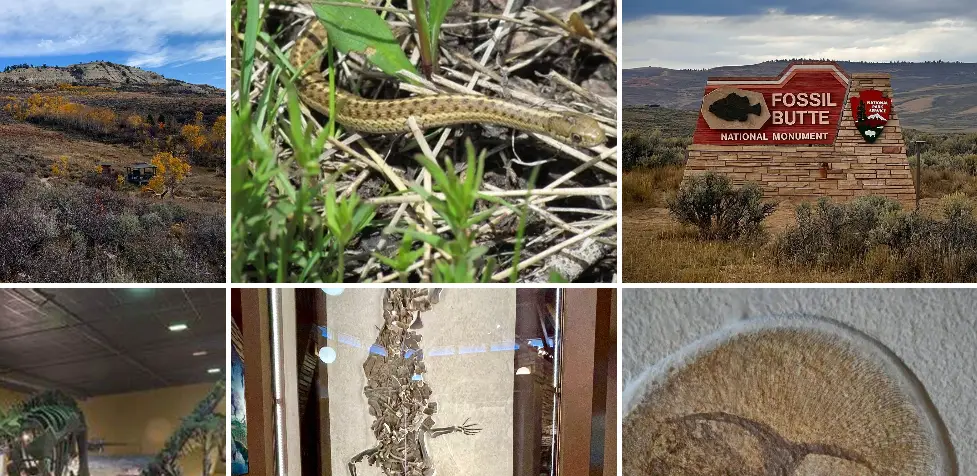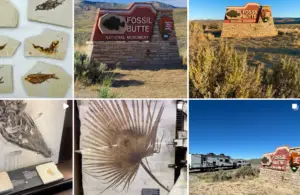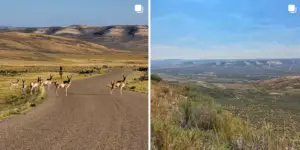Fossil Butte National Monument : Interesting Facts, History & Travel Guide

- By
- Aparna Patel
- |
- 1 Apr, 2023
- |

Fossil Butte National Monument is a hidden gem located in southwestern Wyoming, USA. This unique geological wonderland was established in 1972 to preserve the rich fossil deposits that are found in the area. The monument is home to an incredible array of well-preserved fish, plants, and other ancient creatures that once lived in the vast lake that covered the region during the Eocene epoch, roughly 50 million years ago.
Today, visitors can explore the fossil-rich formations, learn about the area’s fascinating geological history, and soak in the natural beauty of the surrounding landscape.
In this blog, we will delve into the fascinating history and explore the interesting facts and travel guide of Fossil Butte National Monument, providing you with all the information you need to plan an unforgettable visit to this remarkable site.
Table of Contents
Interesting facts about Fossil Butte National Monument
- The park was established in 1972 to preserve and interpret the fossilized remains of ancient fish, insects, plants, and mammals that lived in the region during the Eocene Epoch, about 56 to 34 million years ago.
- Fossil Butte National Monument encompasses 8,198 acres of land, including the famous Fossil Butte itself, a prominent rock formation that rises 1,000 feet above the surrounding landscape.
- The fossils found in the park are among the most complete and best-preserved examples of Eocene life in the world. Over 300 species of fish have been identified, along with numerous species of insects, plants, and mammals.
- The park is home to a visitor center that features interactive exhibits, displays of fossils and minerals, and a movie theater. Guided tours and ranger-led programs are also available.
- Fossil Butte National Monument is situated on the western edge of the Green River Basin, an area that was once covered by a shallow lake that teemed with life. The fossils found in the park provide a glimpse into the ancient ecosystems that existed in the region millions of years ago.
- The park is open year-round, but the best time to visit is during the summer months, when the weather is warm and dry. Visitors should be prepared for high altitude conditions, as the park sits at an elevation of over 7,000 feet above sea level.
- The area around Fossil Butte National Monument is also popular with outdoor enthusiasts, offering opportunities for hiking, fishing, camping, and wildlife viewing. The nearby town of Kemmerer is home to several historic sites and museums, including the Fossil Country Frontier Museum and the J.C. Penney Historic District.
Information & History of Fossil Butte National Monument
Fossil Butte National Monument is located in southwestern Wyoming, USA, and is known for its well-preserved fossils from the Eocene Epoch, which took place between 56 and 34 million years ago. The monument covers an area of over 8,000 acres and was established on October 23, 1972, to protect the significant fossil deposits found in the area.
The history of Fossil Butte National Monument begins in the late 19th century when local ranchers and fossil hunters discovered the abundant fossil deposits in the area. In the early 1900s, paleontologists began to take an interest in the fossils and started conducting scientific studies of the region.
In the 1920s, the American Museum of Natural History conducted extensive excavations of the fossil beds, which led to the discovery of numerous well-preserved fish fossils. These fish fossils were of particular interest as they were some of the most complete and well-preserved fish fossils ever discovered, providing scientists with valuable insights into the evolution of fish.
In 1962, a group of concerned citizens formed the Fossil Basin Promotion Association to advocate for the protection of the area. This group was successful in lobbying for the establishment of the Fossil Butte National Monument in 1972, which was signed into law by President Richard Nixon.
Today, the monument is managed by the National Park Service and provides visitors with the opportunity to explore the park’s fossil deposits through hiking trails, guided tours, and a visitor center. The park is home to over 300 species of fish, along with numerous species of insects, plants, and mammals, providing a window into the ancient ecosystems that existed in the region millions of years ago.
Fossil Butte National Monument continues to be an important site for scientific research and education, as well as a popular destination for visitors interested in paleontology and natural history.
Read More:
- Fort Union National Monument : Interesting Facts, History & Travel Guide
- Fort Stanwix National Monument : Interesting Facts, History & Travel Guide
- Fort Pulaski National Monument : Interesting Facts, History & Travel Guide
- Fort Ord National Monument : Interesting Facts, History & Travel Guide
- Fort Monroe National Monument : Interesting Facts, History & Travel Guide
- Fort McHenry National Monument : Interesting Facts, History & Travel Guide
Travel Guide for Fossil Butte National Monument
Fossil Butte National Monument is a unique and fascinating destination for visitors interested in paleontology and natural history. Here is a travel guide to help plan your visit:
- Getting there: Fossil Butte National Monument is located near the town of Kemmerer in southwestern Wyoming. The nearest airport is the Salt Lake City International Airport, which is about a three-hour drive from the park. Visitors can also reach the park by car via the US 30 highway.
- Visitor Center: Start your visit at the visitor center, where you can learn about the park’s history, geology, and fossils through exhibits, interactive displays, and a movie theater. The visitor center is open year-round, with reduced hours during the winter season.
- Hiking Trails: Fossil Butte National Monument offers several hiking trails that provide access to the park’s fossil deposits and stunning landscapes. The Fossil Lake Trail is a popular option, which takes visitors through the ancient lakebed where many of the park’s fossils were found. The Marsh Trail and the Nature Trail are other options that provide beautiful views of the park’s landscapes.
- Ranger-Led Programs: The park offers a range of ranger-led programs, including guided hikes, talks, and educational programs for children. Check the park’s website for a schedule of upcoming programs and events.
- Camping: Fossil Butte National Monument does not have any campgrounds within its boundaries, but visitors can camp at nearby locations such as the Kemmerer South KOA or the Fossil Butte RV Park. The park does offer picnic areas for visitors to enjoy a meal in the great outdoors.
- Nearby Attractions: The town of Kemmerer is located near the park and offers several attractions for visitors, including the Fossil Country Frontier Museum and the J.C. Penney Historic District.
- Weather: Fossil Butte National Monument is situated at a high altitude, and the weather can be unpredictable. Visitors should be prepared for cold temperatures, high winds, and sudden changes in weather conditions.
Overall, Fossil Butte National Monument is a unique and fascinating destination that offers visitors a glimpse into the ancient past of the region. Whether you’re interested in paleontology, hiking, or just enjoying the great outdoors, this park is definitely worth a visit.
Read More Articles:
- Fort Matanzas National Monument : Interesting Facts, History & Travel Guide
- Florissant Fossil Beds National Monument : Interesting Facts, History & Travel Guide
- Fort Frederica National Monument : Interesting Facts, History & Travel Guide
- Yosemite National Park: Interesting Facts, History & Information
FAQ about Fossil Butte National Monument
What is Fossil Butte National Monument?
Fossil Butte National Monument is a park located in southwestern Wyoming, USA. It is known for its well-preserved fossil deposits from the Eocene Epoch, which took place between 56 and 34 million years ago.
What kind of fossils can be found in Fossil Butte National Monument?
The park is known for its well-preserved fish fossils, but also contains fossils of insects, plants, and mammals. The fish fossils are particularly notable, as they are some of the most complete and well-preserved fish fossils ever discovered.
How can I explore the park’s fossil deposits?
Visitors can explore the park’s fossil deposits through hiking trails, guided tours, and exhibits at the park’s visitor center.
Are there any campgrounds in Fossil Butte National Monument?
No, the park does not have any campgrounds within its boundaries. Visitors can camp at nearby locations such as the Kemmerer South KOA or the Fossil Butte RV Park.
Is Fossil Butte National Monument open year-round?
Yes, the park is open year-round, although the visitor center has reduced hours during the winter season.
Are pets allowed in the park?
Pets are allowed in the park but must be on a leash at all times. Pets are not allowed on hiking trails or in buildings.
Is there an entrance fee to visit Fossil Butte National Monument?
Yes, there is an entrance fee to visit the park. The current fee is $10 per person and is valid for seven days.
Are there any ranger-led programs available?
Yes, the park offers a range of ranger-led programs, including guided hikes, talks, and educational programs for children. Check the park’s website for a schedule of upcoming programs and events.
Can I collect fossils in Fossil Butte National Monument?
No, it is illegal to collect fossils or disturb the park’s fossil deposits. Fossil collecting is strictly prohibited.
Is Fossil Butte National Monument accessible for people with disabilities?
The park offers accessible facilities and programs for visitors with disabilities. Visitors should contact the park in advance to make arrangements for any special needs or requests.
Search Posts
Latest posts
-
5 Mar, 2024
Passing through airport security with autism
Popular posts
-
5 Mar, 2024
Why prohibit engine braking?

